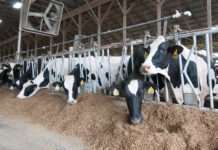The multibillion-dollar Trump tariff payments to farmers, born of the China-U.S. trade war, are expanding the government role in agriculture despite decades of free-market reforms that told farmers to pursue profits rather than subsidies. “I don’t like to see that precedent, but farmers need the assistance,” said Sen. Pat Roberts, father of the 1995 “freedom to farm” law that removed most federal controls over what farmers grow, on Tuesday.
Agriculture Secretary Sonny Perdue says the USDA, at President Trump’s direction, will spend $15 to $20 billion this year in a new round of trade mitigation payments. Details “will be forthcoming shortly, but we want to be clear that the program is being designed to avoid skewing planting decisions one way or another,” said a USDA spokesperson.
Nonetheless, soybean prices fell abruptly and corn prices rose at the Chicago futures markets following a published report saying the new mitigation package would pay $2 a bushel for soybeans and 4¢ a bushel for corn. A $2-per-bushel payment would be “a huge incentive” to plant soybeans, analyst Kelly Herrick of Advance Trading told AgriCensus. The United States is forecast to have nearly 1 billion bushels in storage – a record-large inventory – when the new crop is ready to harvest.
The new Trump payments would amount to more than double the $8.5 billion that has been paid so far on 2018 production of almonds, cotton, corn, dairy, pork, soybeans, sorghum, sweet cherries, and wheat. And the $15 to $20 billion would be on top of $11.5 billion previously forecast for federal payments this year. Last year, direct farm payments totaled $13.8 billion, largest in 12 years, because of trade mitigation aid.
“I know Sonny Perdue wants to administer this program as best he can under the banner of fairness and the obvious need for it,” said Roberts, chairman of the Senate Agriculture Committee. “I hate to rely on these mitigation payments and once again, you’re getting the government determining how much a farmer will receive. I thought we got rid of that in 1996.” Roberts spoke to reporters after a committee hearing.
“Freedom to farm” completed the work begun by the 1985 and 1990 farm policy laws to allow farmers to adjust their mix of crops based on market prices rather than growing the same crops again and again to preserve eligibility for subsidies. The farm program also usually required farmers to idle part of their land each year. The free-market reforms of the 1980s and 1990s encouraged growers to sell their crops rather than put them into federal stockpiles. The 1996 law was enacted as worldwide demand for food surged and U.S. farmers wanted to cash in on it.
According to Bloomberg, this year’s Trump payments will be modeled on the lines of the 2018 package “though the payments will be more generous,” according to two unnamed sources. Payments of $2 a bushel for soybeans, 63¢ a bushel for wheat and 4¢ a bushel for corn would be larger than the 2018 formula of $1.65 a bushel for soybeans, 14¢ a bushels for wheat, and 1¢ a bushel for corn. Other commodities would receive aid, similar to the 2018 package that covered nine commodities. Bloomberg said the administration “is considering basing payments on the acreage farmers plant this year and their historic yield” per acre.
“Tying payments to plantings will lead to distortions, and will make soybeans attractive relative to corn if the payment rates are as reported,” said economist Joe Glauber of the think tank IFPRI. “With the wet spring, acres were already moving to soybeans despite the low prices.”
“Farmers should continue to make their planting and production decisions with the current market signals in mind, rather than some expectation of what a farming support program might or might not look like, based on inaccurate media stories,” said the USDA.
While USDA designs the new aid program, groups such as the National Corn Growers Association say they deserve a higher payment rate and there are calls to cover more crops. California lawmakers plugged for aid to more “specialty” crops, such as grapes and walnuts, reported the Sacramento Bee. Rep Josh Harder spearheaded a bipartisan letter asking that all specialty crops – fruits, nuts, and vegetables – be included.
Credit: https://www.agriculture.com/news/business/trade-war-expands-government-role-in-agriculture-despite-decades-of-free-market




